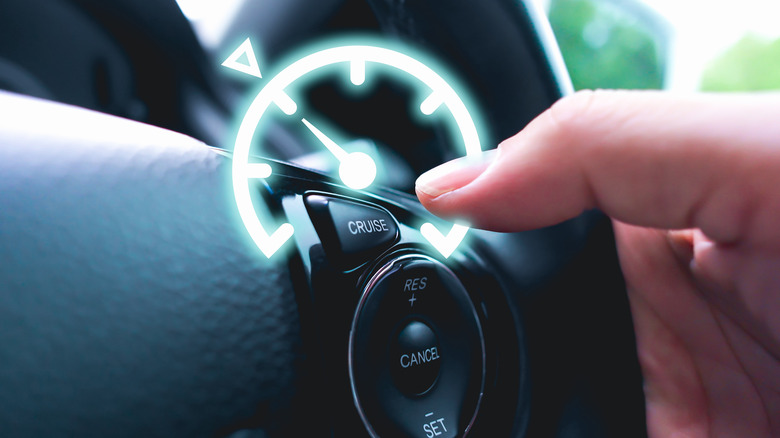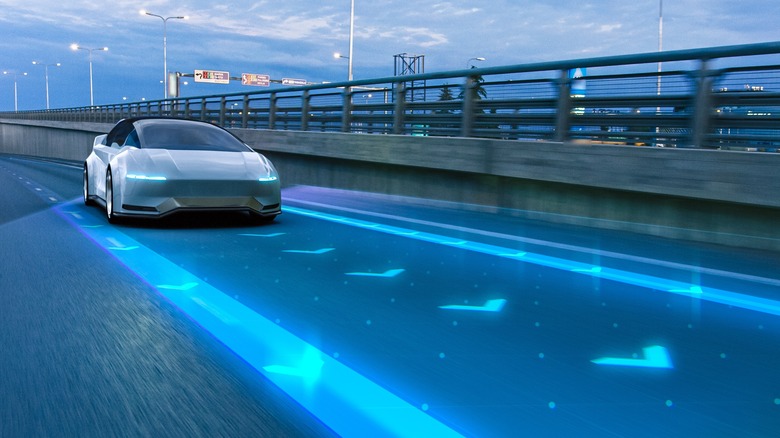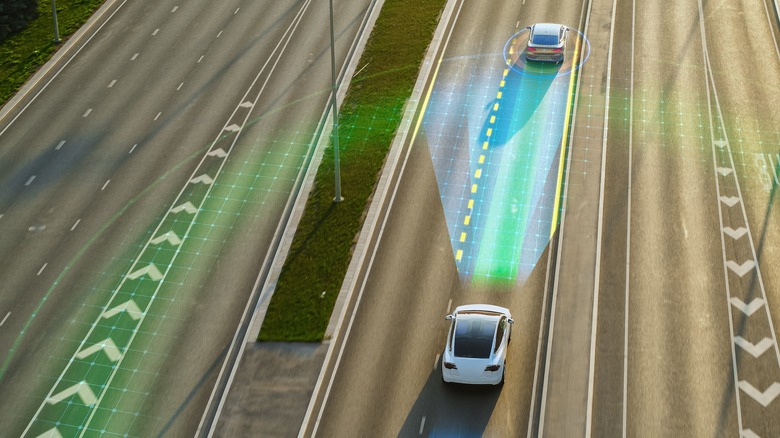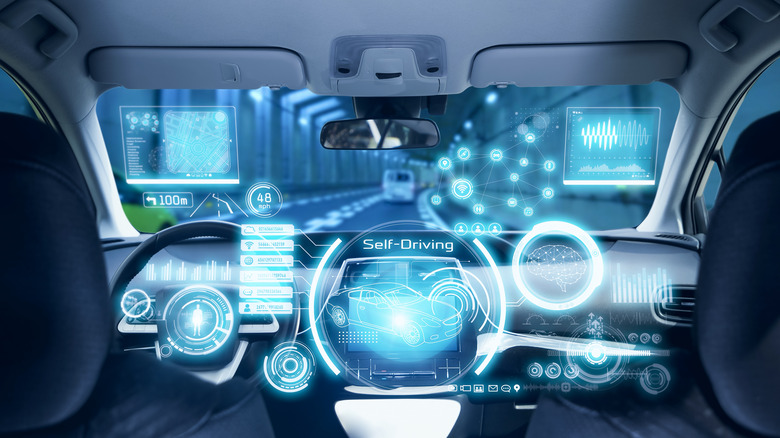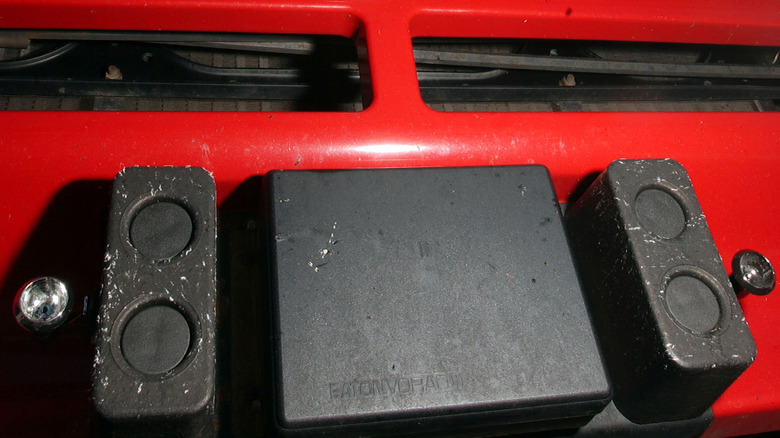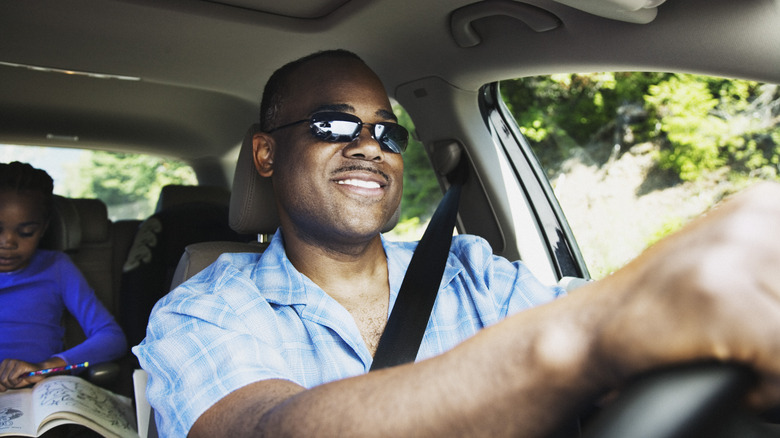Cruise Control Explained: How It Works, And When You Should Use It
Self-driving cars are becoming increasingly intelligent, but whether they'll ever be ubiquitous and fully capable remains unclear. Tesla notes (for now) that its Full Self Driving Capability is "intended for use with a fully attentive driver, who has their hands on the wheel and is prepared to take over at any moment." For many drivers at present, the automatic functions of their cars are limited to the likes of beeping sensors, flashing displays, and features like cruise control.
Cruise control is a feature provided as standard on a wide range of vehicles; it's one of those functions that some drivers adore and others barely use. While the feature doesn't take over from the driver by any means, it can significantly ease their burden. Essentially, cruise control allows drivers to select an appropriate speed for the road, conditions, and general journey they're currently on, and automatically prevents the vehicle from deviating from that speed.
Experienced drivers, of course, will probably be familiar with the basics of what cruise control does, even if they haven't really used it themselves. Rather more complex than that, though, is the question of exactly how it keeps the vehicle moving at a specific speed. If you've ever wondered how cruise control works, what the pros and cons of using it are, how it's developed since its introduction, and/or when to use it, this is just the piece for you.
The essentials of how cruise control works
Cruise control as we know it today has its roots in the ingenuity of Ralph Teetor. Though he lost his vision following an accident, Teetor rose to become the president of the Society of Automotive Engineers. In that capacity, he used both his passion for auto safety and his extensive experience with other drivers to create the first example of cruise control. In 1950, Teetor held a patent for technology referred to as a "Speed Control Device For Resisting Operation Of The Accelerator," also called the Speedostat, and it worked just as the name implied: the driver could opt for a certain speed by selecting it from the dash, then, through the drive shaft, a piston would provide resisting force on the pedal after arriving at that speed.
The basics of how cruise control functions haven't actually changed very much. Depending on the vehicle model, the input for choosing the desired speed may now be a touchscreen, but the effect is the same: a connected actuator receives the signal from the control device, and, as it runs to the valve for the throttle, is used to control the strength of the force acting on the throttle. Accelerating faster or slower depending on how much faster the inputted speed is, the vehicle will then reach said speed and hold the accelerator in place (though not necessarily physically as Teetor's Speedostat did). This is a mechanically-oriented form of cruise control, but some modern vehicles utilize adaptive cruise control instead.
How is adaptive cruise control different?
The basic concept of cruise control, of course, is centered more around what the specific vehicle is doing, rather than what's on the road around it. Drivers can simply brake as they typically would in response to other drivers, overriding the constant-speed effect of cruise control, which means that autonomy isn't really a factor in cruise control beyond maintaining the speed. Adaptive cruise control like the kind found in some Acura vehicles, however, is a little more sophisticated.
Adaptive cruise control is a feature more able to do exactly that: adapt. This means that while the driver selects the vehicle's cruising speed as before, it is not locked to that speed. Another crucial thing to take into account is the vehicle's distance from others; adaptive or autonomous cruise control adds small and discreet radar systems (inputs situated somewhere near the vehicle's front lights) to the equation to monitor the surrounding area. These radars have ranges from approximately 100 feet to around 600 feet, depending on the vehicle.
A car with ACC will commonly boast small wheel-mounted units that measure its speed, along with a front-mounted one that can determine how far away other vehicles are. The former can adjust how fast your vehicle is moving relative to any motorists ahead, thereby ensuring that you always maintain your selected distance from them. Braking capacity while the system is active differs, but typically, the driver will be alerted to brake heavily if necessary (if a driver ahead does the same for instance).
When cruise control should be used
Some drivers often have the luxury of wide, peaceful, near-empty roads. For others, driving tends to be a commuter's cacophony of traffic jams, honking horns, and slow stop-start-stop-start progress. The experience can differ greatly depending on the time of day and whether it's a weekday or the weekend. The bottom line, though, is that one of these scenarios is a far better fit for cruise control than the other.
Brakes remain operational during the use of cruise control, and engaging them will override the system. This means two things: the driver's attention must still firmly remain on the road as ever (we're not at level 5 on the autonomous driving scale here) and cruise control has sharply decreased utility in congested areas. By contrast, if you're a driver who frequently takes long-distance trips on open roads, cruise control could be the perfect feature for you. An alert and rested driver is a safe driver, and where longer journeys can compromise those things, cruise control reduces some of that pressure.
Adaptive cruise control, which monitors the ever-changing road ahead continuously via radar or laser, is potentially better equipped to handle congested roads. There's no definitive answer on whether that's the case, however, because this feature is very different from vehicle to vehicle.
Different manufacturers have different cruise control features
Cruise control is a common feature, and adaptive cruise control is becoming increasingly widespread too. The matter of how the two types of cruise control work is a very complex one beyond the basics, though, because different vehicle manufacturers have developed their own unique features for it and implemented the system in different ways.
For example, Audi's Traffic Jam Assist technology can be activated in tandem with its adaptive cruise control, thereby supporting the driver in conditions that aren't optimal for the latter. By means of ultrasonic sensors, radar, and a windshield camera, the vehicle will maintain a consistent distance from the one ahead in traffic while staying oriented on the road. The driver takes full manual controlwhen the congestion clears or Traffic Jam Assist otherwise becomes unsuitable for the situation.
Similarly, select Ford models are among those that offer Intelligent Adaptive Cruise Control, implementing advanced features such as Speed Sign Recognition (which aims to prevent adaptive cruise control users from being caught out by speed limits by adjusting the chosen speed to match them) and Stop-and-Go (limited capacity to stop entirely in response to a vehicle ahead doing the same). As always, drivers should consult their vehicle manual to determine which cruise control features are available and how to use them.
Pros and cons of cruise control and adaptive cruise control
Cruise control can be advantageous for drivers in other ways too. In its capacity to ensure a vehicle remains at a steady speed, where possible, it can boost driving efficiency. According to Natural Resources Canada, varying your speed by around 6 mph every 18 seconds can be 20% more costly in terms of fuel. Cruise control, in a general sense, aims to be as efficient as possible within the parameters the driver provides, which can potentially translate to less fuel being used over time.
This is only the case when driving for longer stretches on wide, clear roads, however. The reason is that there are certain things human drivers are better at than their machine counterparts, and adjusting speed subtly in response to changes in elevation is one of them. Failing to do so can be wasteful.
On a similar note, Vanderbilt University found that drivers are more adaptable in their thinking and processing of multiple vehicles and their movements on the road, while cruise control features tend to have a rather narrower focus in terms of the vehicle(s) in front. Cruise control can serve as an invaluable tool for drivers, but isn't infallible. Ensuring that you use it for its intended purpose is the key to best taking advantage of it.
